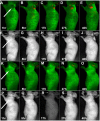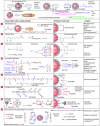Preparation of quantum dot/drug nanoparticle formulations for traceable targeted delivery and therapy
- PMID: 22896770
- PMCID: PMC3418929
- DOI: 10.7150/thno.3692
Preparation of quantum dot/drug nanoparticle formulations for traceable targeted delivery and therapy
Abstract
Quantum dots (QDs) are luminescent nanocrystals with rich surface chemistry and unique optical properties that make them useful as probes or carriers for traceable targeted delivery and therapy applications. QDs can be functionalized to target specific cells or tissues by conjugating them with targeting ligands. Recent advancement in making biocompatible QD formulations has made these nanocrystals suitable for in vivo applications. This review provides an overview of the preparation of QDs and their use as probes or carriers for traceable, targeted therapy of diseases in vitro and in vivo. More specifically, recent advances in the integration of QDs with drug formulations for therapy and their potential toxicity in vitro and in vivo are highlighted. The current findings and challenges for optimizing QD/drug formulations with respect to optimal size and stability, short-term and long-term toxicity, and in vivo applications are described. Lastly, we attempt to predict key trends in QD/drug formulation development over the next few years and highlight areas of therapy where their use may provide breakthrough results in the near future.
Keywords: Drug Nanoparticle Formulations; Quantum dots; Targeted Delivery.
Conflict of interest statement
Competing Interests: The authors have declared that no competing interest exists.
Figures





Similar articles
-
The future of quantum dots in drug discovery.Expert Opin Drug Discov. 2014 Sep;9(9):991-4. doi: 10.1517/17460441.2014.928280. Epub 2014 Jun 16. Expert Opin Drug Discov. 2014. PMID: 24935029
-
Fluorescent nanocrystal quantum dots as medical diagnostic tools.Expert Opin Med Diagn. 2008 Apr;2(4):429-47. doi: 10.1517/17530059.2.4.429. Expert Opin Med Diagn. 2008. PMID: 23495709
-
Design of multifunctional liposome-quantum dot hybrid nanocarriers and their biomedical application.J Drug Target. 2017 Sep;25(8):661-672. doi: 10.1080/1061186X.2017.1323334. Epub 2017 May 8. J Drug Target. 2017. PMID: 28438041 Review.
-
Cytotoxicity assessment of functionalized CdSe, CdTe and InP quantum dots in two human cancer cell models.Mater Sci Eng C Mater Biol Appl. 2015 Dec 1;57:222-31. doi: 10.1016/j.msec.2015.07.044. Epub 2015 Jul 26. Mater Sci Eng C Mater Biol Appl. 2015. PMID: 26354258
-
Quantum dot as probe for disease diagnosis and monitoring.Biotechnol J. 2016 Jan;11(1):31-42. doi: 10.1002/biot.201500219. Epub 2015 Dec 28. Biotechnol J. 2016. PMID: 26709963 Review.
Cited by
-
Quantum dots for biophotonics.Theranostics. 2012;2(7):629-30. doi: 10.7150/thno.4757. Epub 2012 Jul 4. Theranostics. 2012. PMID: 22896767 Free PMC article.
-
Nanotechnology-based antiviral therapeutics.Drug Deliv Transl Res. 2021 Jun;11(3):748-787. doi: 10.1007/s13346-020-00818-0. Drug Deliv Transl Res. 2021. PMID: 32748035 Free PMC article. Review.
-
Microenvironmental Impact on InP/ZnS-Based Quantum Dots in In Vitro Models and in Living Cells: Spectrally- and Time-Resolved Luminescence Analysis.Int J Mol Sci. 2023 Jan 31;24(3):2699. doi: 10.3390/ijms24032699. Int J Mol Sci. 2023. PMID: 36769021 Free PMC article.
-
Fabrication and characterization of a folic acid-bound 5-fluorouracil loaded quantum dot system for hepatocellular carcinoma targeted therapy.RSC Adv. 2018 May 29;8(35):19868-19878. doi: 10.1039/c8ra01025k. eCollection 2018 May 25. RSC Adv. 2018. PMID: 35541013 Free PMC article.
-
Next-Generation Theranostic Agents Based on Polyelectrolyte Microcapsules Encoded with Semiconductor Nanocrystals: Development and Functional Characterization.Nanoscale Res Lett. 2018 Jan 25;13(1):30. doi: 10.1186/s11671-018-2447-z. Nanoscale Res Lett. 2018. PMID: 29372483 Free PMC article.
References
-
- Azzazy HME, Mansour MMH, Kazmierczak SC. From diagnostics to therapy: Prospects of quantum dots. Clinical Biochemistry. 2007;40:917–27. - PubMed
-
- Prasad PN. Nanophotonics. New York: Wiley-Interscience; 2004.
-
- Prasad PN. Biophotonics. New York: Wiley-Interscience; 2004.
-
- Farokhzad OC, Langer R. Nanomedicine: Developing smarter therapeutic and diagnostic modalities. Advanced Drug Delivery Reviews. 2006;58:1456–9. - PubMed
Grants and funding
LinkOut - more resources
Full Text Sources
Other Literature Sources

